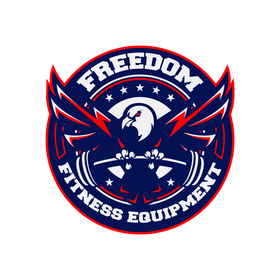Are you tired of lifting that empty barbell? Are 3 sets of 50 back squat reps starting to get old? Do you wish you could somehow make that barbell heavier, increase your strength, and most importantly build bulging biceps (just not in a squat rack at a commercial gym - don't be that guy)?
Well, lucky for you, I am going to let you in on a secret hack in the fitness world - weight plates.
Okay, okay, maybe this secret has been out for quite some time. Actually, according to a quick Google search, Babe Ruth or Albert Einstein could have been the first members of the 1000lb club as the weight plate was first introduced in the late 1920s.
All joking aside, if you ended up reading this article, you are likely looking for a new set of wheels for your barbell. But, like with many pieces of equipment in the fitness space, there are so many options that it can be slightly overwhelming. There are many questions you may be asking. Should I buy cast iron? How about bumper plates? Does it matter if my bumper plates are competition plates? How much should I expect to spend?
That's why we are here. We want to help and guide you in selecting the perfect weight plates for your gym.
Here is Your Guide for Buying Weight Plates:
Why are you buying?
Answering this question makes the rest of the process much easier. The buying needs for a commercial gym versus a powerlifting-focused home gym versus a CrossFit gym are going to be drastically different. Consider your goals and reasons for training, as this will come in handy as we talk through other questions later on. A couple of questions to begin thinking through:
-
What style of training are you participating in?
-
Do you have goals of entering competitions?
What Type of Weight Plates?
There are primarily two broad categories that most weight plates fall under - metal weight plates and bumper plates. Now we will look at the differences between these plates and who the plates are best designed for based on training goals and style.
Traditional Cast Iron & Steel Weight Plates
These weight plates have been a staple in commercial gyms for years. Cast iron plates are what you will see Ronnie Coleman repping out as he's yelling, "Yeaaaaa buddy."
They are the weight plates that give the deep clanking sound as if they are applauding the effort and weight you chose that day.
Cast iron plates are finished with typically either a silver or black coating and some old-school lettering. They come in the standard weight ranges typically 2.5lbs to 45lbs, however, you can find plates up to 100lbs and as low as .25lbs.
One negative we can sometimes see with these plates is that they tend to chip with "wear and tear" - and what we really mean is by lifting heavy and often. We like to refer to it as adding a little character to the plate.
Who Are Traditional Cast Iron and Steel Weight Plates Best For?
Cast iron plates are a good option for the general fitness population and are perfect for anyone wanting that "old-school" feel. Whether you are training bodybuilding, powerlifting, or strongman these can be a great option.
These plates are typically on the lower end of the budget scale in comparison to other types. We would primarily recommend these weight plates for those in the training styles mentioned above. If you have no interest in Olympic weightlifting these will do just fine for you as you should never drop metal weight plates from overhead. These plates are great for general use, fairly cost-effective, and have great durability, however, - spoiler - we do believe there are better options available.
Powerlifting Steel Weight Plates
These plates are designed to be as thin as possible. As the sport of powerlifting grows and humans are getting stronger and stronger - standard barbells can be simply too small to hold traditional metal plates when lifting seven or eight hundred or even one thousand plus pounds. Powerlifting steel plates can be as thin as 1/3 the width of a bumper plate. Just based on simple math, you can see how much more weight can be loaded on a barbell using these plates.
Who Are Powerlifting Steel Weight Plates Best For?
As the name implies, this one is pretty simple - serious powerlifters.
If you are dedicated to your powerlifting goals and aim at being or are already a competitor you may want to consider the thin powerlifting steel plates.
However, for most people, the traditional steel plates are plenty thin enough.
Bumper Plates
Bumper plates, also known as rubber weight plates, function in all the same ways as traditional iron or steel plates except they are designed to be dropped. Bumper plates are generally much thicker in comparison to cast iron or steel weight plates.
Because of their rubber makeup and larger surface area, bumper plates bounce off the floor and handle the contact much better than metal plates.
If you are new to the world of weight plates and especially bumper plates, one thing you may not know is they traditionally come color coded. Here's a quick cheat sheet for your bumper plates:
-
Red Bumper Plates - 55lbs or 25kgs
-
Blue Bumper Plates - 45lbs or 20kgs
-
Yellow Bumper Plates - 35lbs or 15 kgs
-
Green Bumper Plates - 25lbs or 10kgs
Who Are Bumper Plates Best For?
Because they function in many of the same ways, bumper plates can be used in many of the same situations that traditional plates can. Anyone from general fitness users, to strongmen, bodybuilders, and powerlifters can great a great workout in with bumper plates.
However, because they can be dropped, bumper plates are necessary for weightlifters and CrossFit athletes.
Performing movements like clean and jerks and snatches with cast iron or steel plates is a bad idea. Bumper plates were invented to solve this problem. During the 20th century Olympics, athletes were required to perform their lifts and then control the weight back down to the floor. As you can imagine, it's pretty hard to control a maximal effort lift on the way down (much less a failed snatch) and there was a constant struggle to keep the lifting platforms in one piece. The solution - a bumper plate. It wasn't until the 1970s when we saw the introduction of the bumper plate, and today they are quite common not only in weightlifting gyms but in commercial and CrossFit gyms as well.
One thing to be aware of if you plan on dropping your bumper plates, it is not recommended to drop a barbell with anything less than a 25lb bumper plate on each side. This is because the smaller bumper plates are not strong enough to handle the impact and can crack and split over time. This is not a big issue as typically, for the average person, if the weight is that light it's easy to control down to the floor from overhead.
Crumb Rubber Bumper Plates
Crumb rubber bumper plates are practically the same as traditional bumper plates with the main difference being the look and feel. They are made of recycled rubber and feel similar to rubber gym flooring. Crumb rubber bumper plates are made of recycled rubber and are a great option, but often are not as well made as traditional high-quality bumper plates. However, on the flip side, they are typically cheaper.
Who Are Crumb Rubber Bumper Plates Best For?
If you don't mind not having smooth, color-coded bumper plates and are looking for a more cost-effective option - these may be a great alternative for you.
Although we don't recommend storing plates outdoors, if you need to use your weight plates in the fresh air, these may also be great for that. Not only because they are cheaper, but a crumb rubber bumper plate handles scuffs and concrete better than the traditional metal and bumper plates.
Urethane Weight Plates
Urethane is basically a man-made rubber, and it typically has a harder feel to it in comparison to traditional bumper plates. Because it is harder than rubber, it is not as ideal to drop urethane weight plates, although some handle it better than others. Think of it almost as an in-between of traditional bumper plates and metal plates. If you have ever been to a YMCA or Crunch Fitness, these are likely the plates you used there.
Like the bumper plates, these are incredibly durable plates. Another plus to urethane is that because they are harder, they handle engraving better and appear to have the "new" look and feel for longer than other types of plates.
Who Are Urethane Weight Plates Best For?
Urethane is ideal for a commercial gym for a few reasons. First, they are incredibly durable plates. Whether it is the actual plates or the logos and engravings, you can be sure your urethane plates are going to look newer for longer. Second, at commercial gyms, there is typically not as much of a bumper plate need for Olympic lifting, so not having the ability to drop the barbell from overhead is not a big issue. Finally, you get a lot of the benefits of traditional bumper plates without the space needed to store them. Urethane weight plates vary in size but are typically smaller in width than a traditional bumper plate - meaning maximal storage for those coveted bench press weight tree racks.
Questions to Consider
Now that we have looked at the most common options when it comes to weight plates, let's answer those questions I know you are dying to ask.
How Much Weight Do I Need To Buy?
As you begin to search the internet, you probably have noticed that most companies offer weight packages - ranging from around 100lbs to well over 1000lbs.
These packages are not only more convenient than buying weight plates individually, they are typically a little bit cheaper.
So now to the question. Like many other questions, this one is highly dependent on your training style and goals. For the beginner lifter looking to build your first home gym, somewhere around a 300lb set will likely be more than enough. However, if you are a professional powerlifter, you may be looking at needing 700lbs +. Gym needs vary even more so, considering things like the number of members, training style of members, and how many machines, squat racks, and weight trees need to be filled is important.
For most people, the question of how much weight your home gym needs is going to come down to the heaviest lift you plan on attempting.
For many, this will be a deadlift or squat, so make sure you purchase enough weight to not only perform your highest lift today but also a little bit extra for the lifetime PR we know you have in you.
As a way to provide that extra bit of motivation, you can instead purchase exactly the weight needed today, telling yourself you will only buy more when you can lift it. This can serve as a reward for your hard work and skyrocketing PRs.
What Combination of Weight Plates Should I Buy?
For the beginner, one of the best and most common combinations is:
(4) 45lb plates
(2) 25lb plates
(2) 10lb plates
(2) 5 lb plates
As you need more weight really the one plates to buy are 45s. If you use this model, you could buy one more set of 10s and a set of 2.5s, but other than that any weight combination can be reached with what you have.
For that reason, this is a great starter set.
And please don't buy 35s or 15s.
What About Smaller Change Plates? Big Plates? Training Bumper Plates?
Change plates can be as small as 0.25lbs. For 99% of the population, these are incredibly unnecessary. Unless you are a powerlifter seriously chasing a world record, you don't need these. In general, if you are chasing PRs to the point of a quarter pound - that is not a solid training plan. Progressive overload is a wonderful, magical thing, but like anything, it can be taken too far, and using change plates that small to constantly increase weight is a great example of that. We recommend 2.5lb plates as the smallest you need.
Similarly, some companies make 100lb plates. For 99% of people, these aren't necessary either.
A training bumper plate is a 5 or 10-pound set of bumper plates that are the diameter of a 45-pound bumper plate. This is already the standard size for a 10-pound bumper plate but not as common with the 5-pound bumper plate. The purpose of training bumper plates is to give the athlete the same start spot to begin to build technique - think cleans, snatches, deadlifts - without the weight they aren't ready for. If you are new to Olympic lifting or plan on teaching a friend or even your kids, this could be good to make sure you have.
How Much Should I Expect To Spend?
Most weight plates are priced on a rough per-pound basis. So, in general, a 45lb plate and a 5lb plate from the same company and made of the same material will be priced somewhere between 1.5x and 9x their weight. For example, you can expect to spend between about $70 (45 x 1.5) and $405 (45 x 9) for a 45lb plate. Obviously, that is quite a big price difference, so let's break it down by type of plate.
We will start with the cheapest options. The two most cost-effective options are going to be the crumb rubber bumper plate and the traditional cast iron and steel plates. When looking to purchase crumb rubber bumper plates or traditional iron or steel plates you can expect to spend anywhere from 1.5x to 2x the weight.
Next, the thin steel plates. Compared to their traditional counterparts they are not relatively much more expensive. You can expect to spend between 2 to 3x.
The bumper plates round out the list (see what I did there). These can be quite expensive, but don't have to be. You can find standard rubber bumper plates from anywhere from 2 to 6x. Expect similar prices from the urethane weight plates (around 3 to 4x). Finally, here's where that giant 9x number came in - competition bumper plates. These vary from 3 to 9x, and it largely depends on the certification of the bumper plates. If you want the International Weightlifting Federation-compliant competition plates - expect to pay the 9x. Unless you just enjoy spending money on your home gym - or are looking for an expensive centerpiece for your kitchen table - you almost certainly don't need these.
Do I Need Calibrated, Certified, or Competition Plates?
The short answer is probably not. Primarily what this means is that the plates are under specific standards they must meet - such as for the accuracy of the weight.
The truth is almost all plates are within a very, very marginal error to what they say on the plate, regardless of whether or not they are for a specific organization.
Typically, the only time to consider accuracy in weight is when buying used plates - especially metal plates. Because metal plates can chip and rust it is important to weigh them before buying. Be sure to check out our article on buying used gym equipment if that is something you are considering.
Our Picks
As you've seen there are quite a few options when it comes to purchasing your weight plates. There are pros and cons for each type as we've talked about, but here's a quick rundown of our favorite options.
-
Overall Favorite: Rouge Echo Bumper Plates
The rubber bumper plate takes the cake - it's incredibly versatile and durable. As long as you have adequate flooring, you can drop it without concern of damage to your floor or bumper plates. There is maximum functionality with these bumper plates, and the only thing you potentially couldn't do is load the barbell with 700lbs plus due to their width - which I know is probably something you are quite concerned about.
With reasonably priced options, it is hard to beat the bumper plates. They are the best bang for your buck and overall value.
These are not only the best rubber weight plates but we believe they are the best plates for overall value.
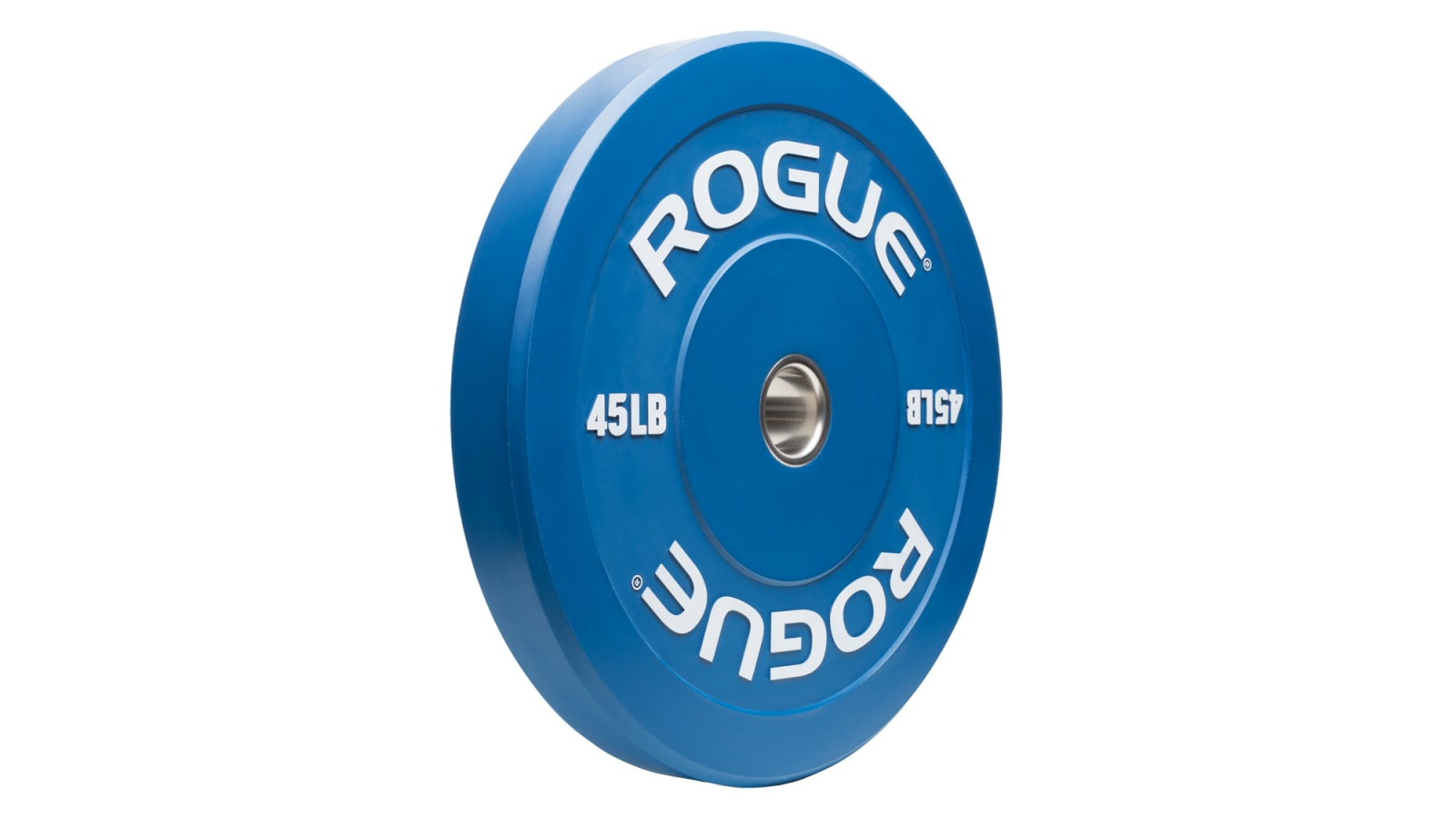
-
The One That Doesn't Break the Bank: Freedom Fitness Equipment's Crumb Rubber Plates Package
I know what you are thinking - "We've got inflation, high gas prices, and a not-so-great stock market, give me the best option that doesn't ruin my budget." Don't worry I got you.
This one was a close one between the metal plates and the crumb rubber. But, in our opinion, crumb rubber plates are the way to go - primarily for the added functionality they offer.
Here's one of our weight packages at a great value.
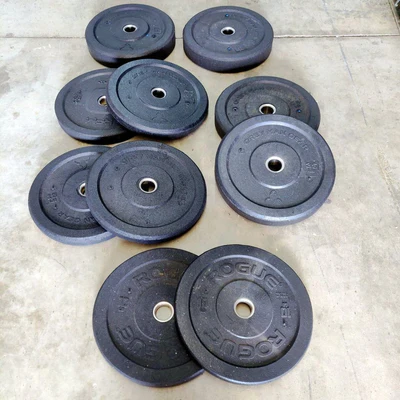
-
General Use and Bodybuilding: Rouge Cast Iron Plates
Maybe you know that Olympic lifting is never something you want to dabble in. You know that your training is going to consist of bench press, shoulder press, squats, and curls. You love the sound of iron plates bouncing around. The best option for you is going to be the traditional cast iron or steel plates. Add in the relatively low cost and you have a great option for your home gym.
Check these out.
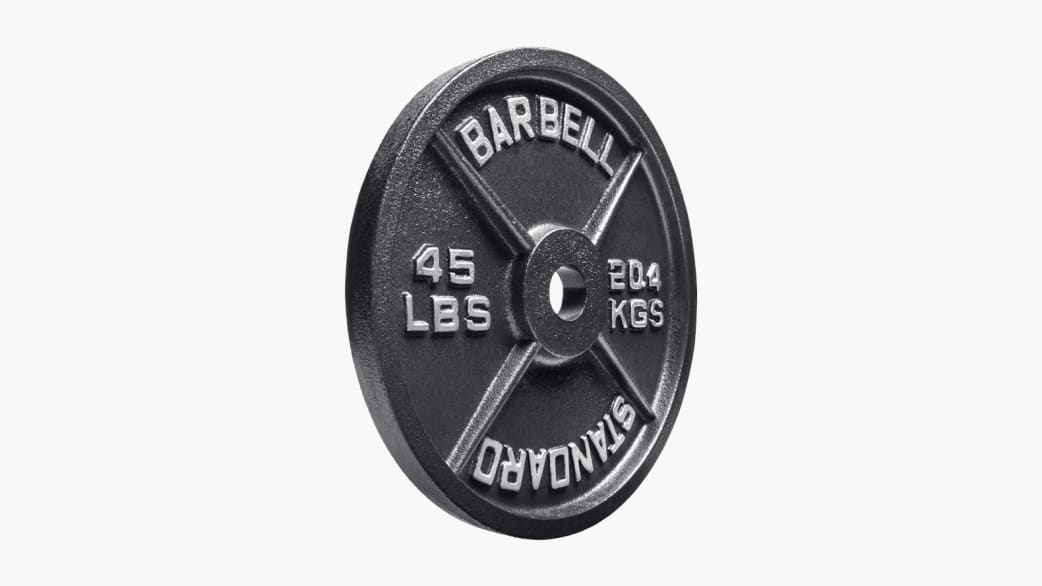
-
Do You Like to Party? FringeSport Pizza & Donut Bumper Plates
Are you a believer in "Look good, feel good, feel good, play good?" If so these weights may be perfect for you. Imagine looking at your weights and seeing a delicious sprinkled donut or pizza - almost instantly you can expect to see a 5lb PR.
Seriously, you have to check out these cheat-day-inspired plates.

We also have vinyl decals that can transform your bumper plates into sushi, donuts, or pizza. Check them out here!
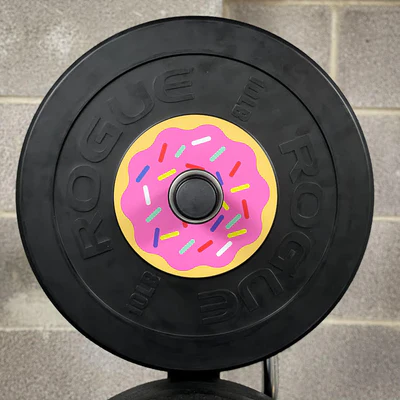
Final Thoughts
Hopefully, by this point, you are feeling quite confident in your ability to choose the perfect set of weight plates for your home gym and your goals. While they are many different options, at the end of the day they almost all have very similar functionality, so don't stress yourself out.
Choose a reputable brand, read the reviews, and your weight plates will last you decades.
As always, we are here to help you as you begin the process of buying weight plates.
Please reach out with any questions you have - whether about weight plates, home gyms, or any other fitness questions you may have. We would love to be a part of helping you achieve your goals and support your fitness journey.
Sources:
Newton, Harvey. “The Story Behind Bumper Plates.” SportsEdTV, 15 Apr. 2021, https://sportsedtv.com/blog/the-story-behind-bumper-plates#:~:text=During%20the%2 01972%20Munich%20Olympic,a%2025kg%20rubber%20bumper%20plate.
Pinola, Joseph. “Rubber vs Urethane Weights: What's the Difference.” TracFitness, TracFitness, 31 Oct. 2019, https://tracfitness.com/blogs/knowledge-center/rubber-vs-urethane-dumbbells-whats-the-difference#:~:text=Urethane%20is%20generally%20more%20harder,plates %20are%20manufactured%20with%20rubber.
“Types of Weight Plates for Lifting & Which Is Best?” SET FOR SET, 2 July 2021, https://www.setforset.com/blogs/news/iron-plates-vs-bumper-plates.
